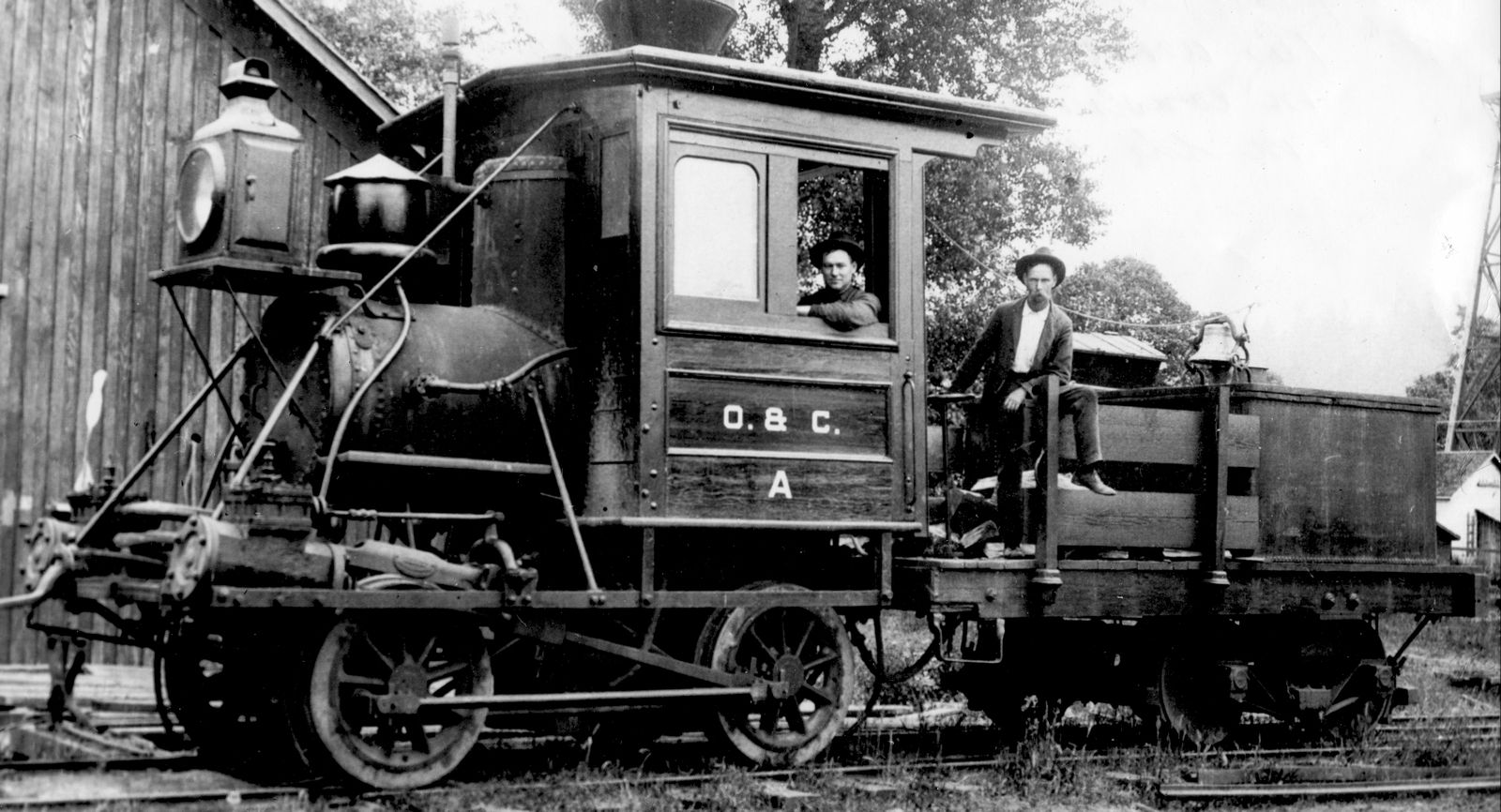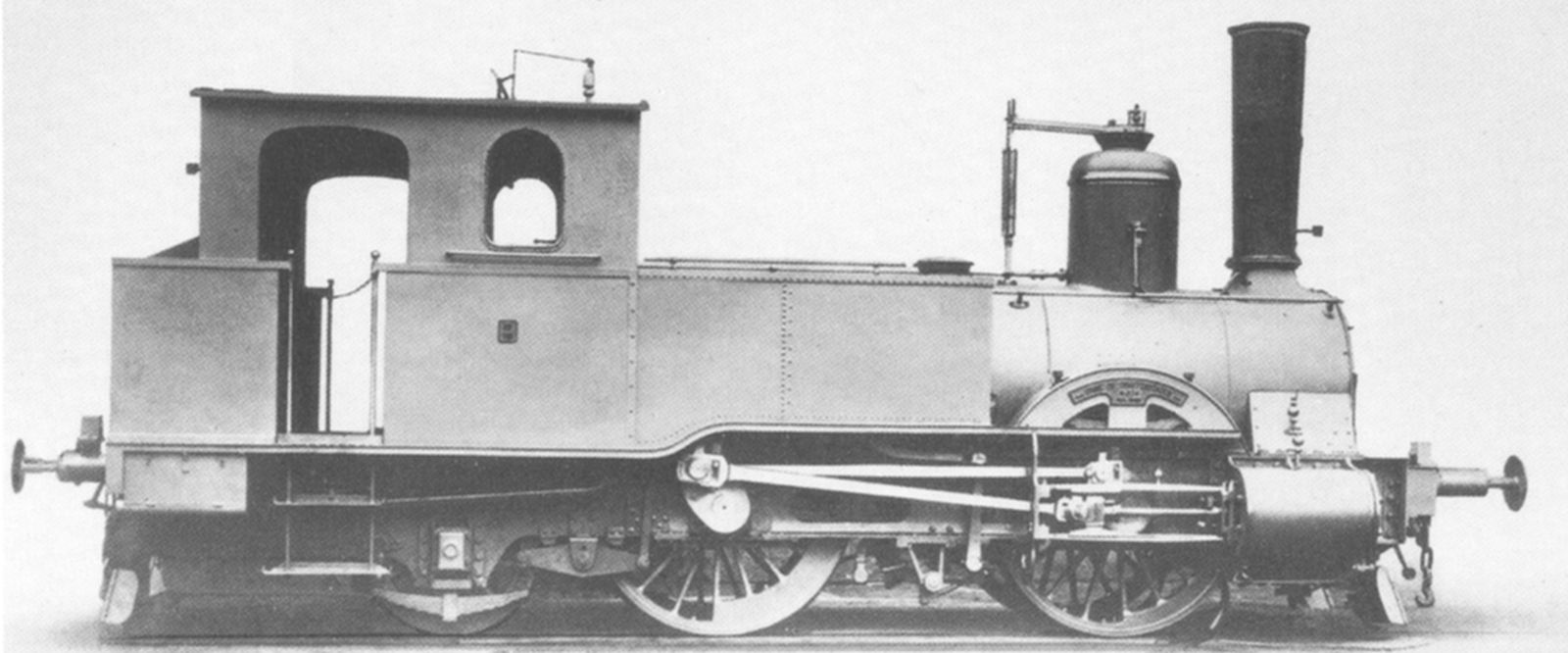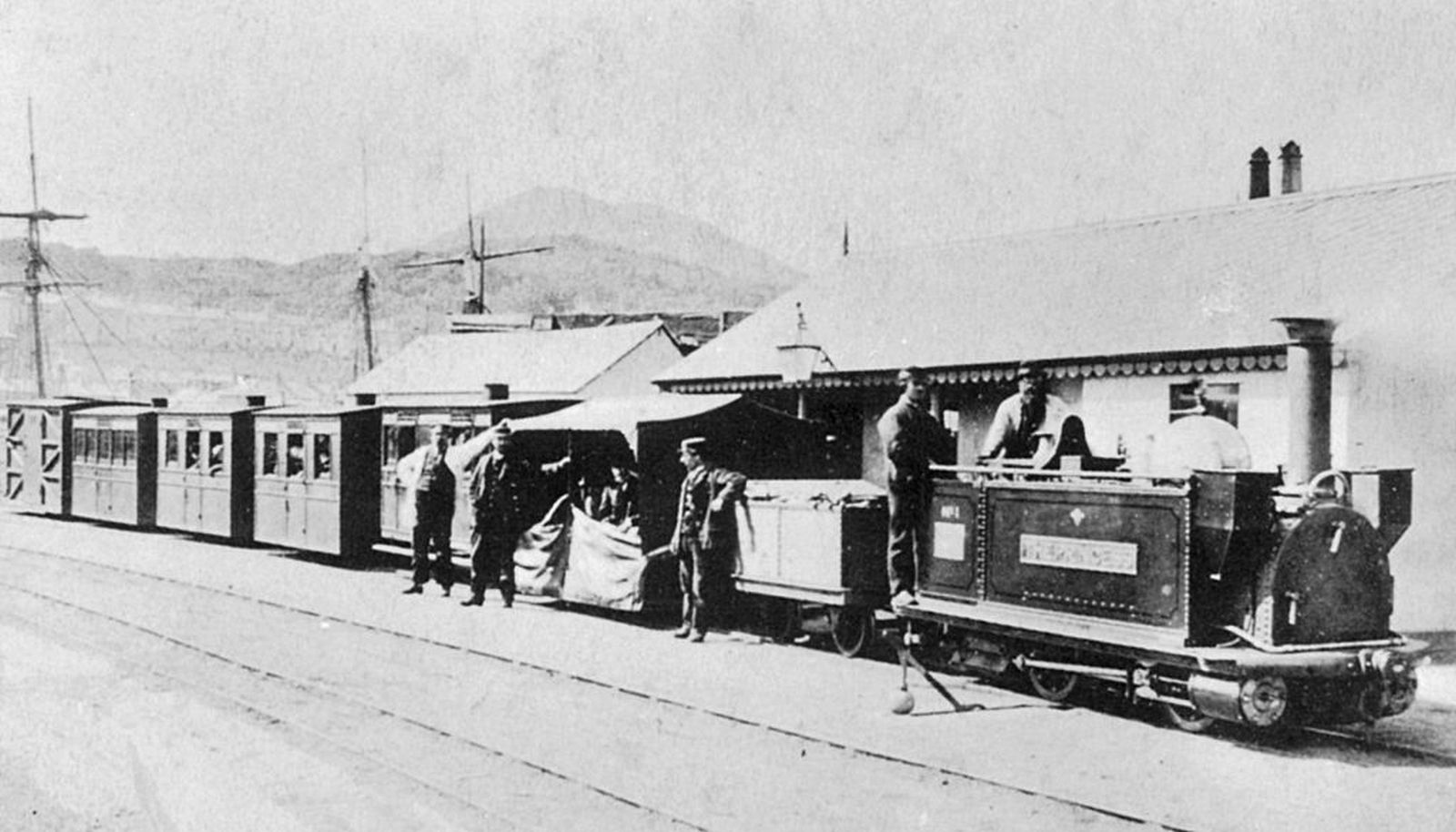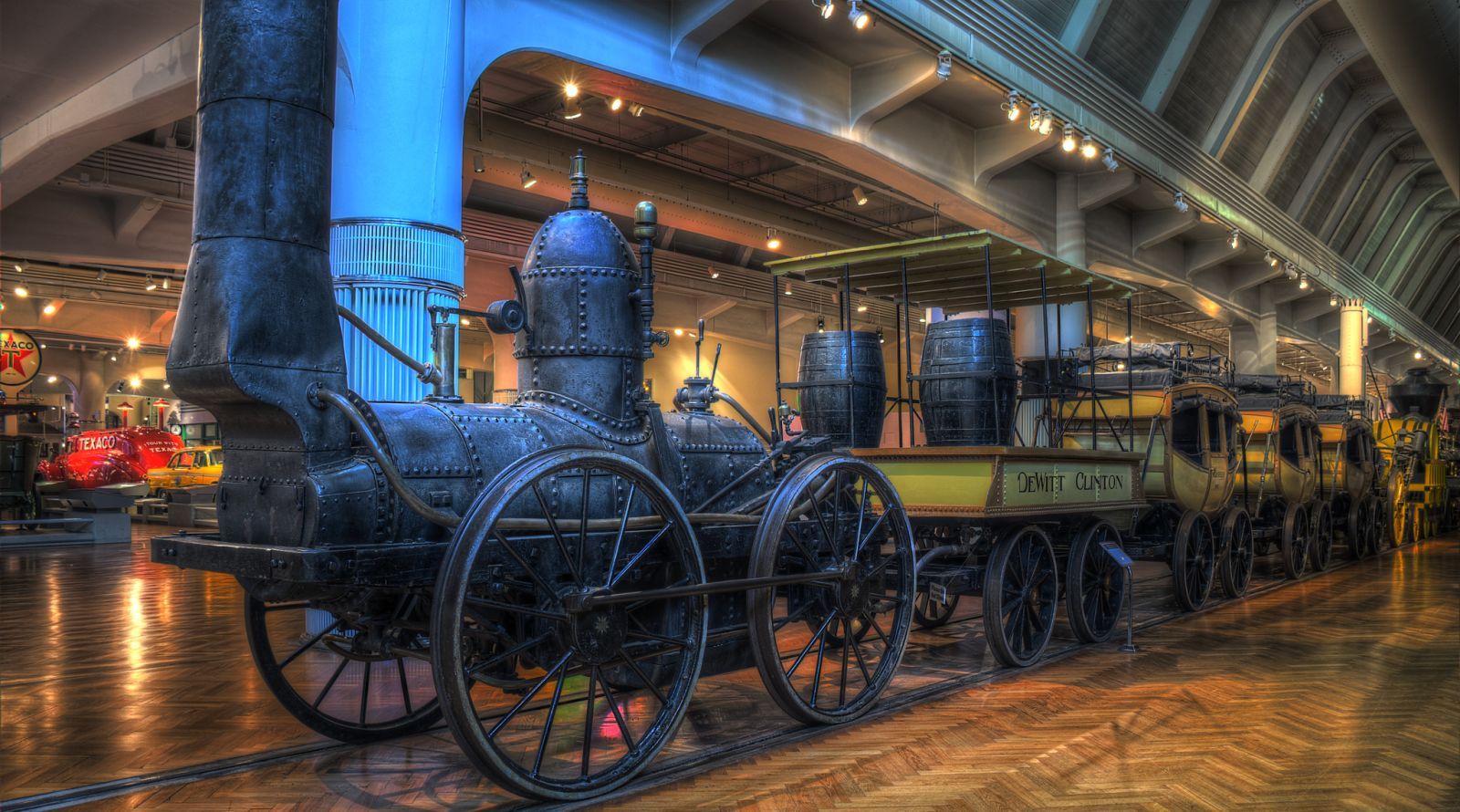One of the simplest types of steam locomotives is the wheel arrangement 0-4-0, which stands for a locomotive with two driven axles and no carrying axles. The following designations exist in the different naming systems:
Four-coupledUICBWhyte0-4-0Switzerland2/2France020Turkey22

“Old Betsy” of the Oregon & California Railroad in 1905 when this photo was taken was believed to be one of the smallest 0-4-0 tender locomotives in North America
Oregon Bureau of Land Management
The first Trevithick locomotives had two axles that were connected to each other. There, a large gear wheel was responsible for ensuring that both axes always rotated synchronously. Stephenson was the first to use the well-known design with coupling rods to create the “Locomotion No. 1” to also drive the second axis. In the years that followed, the 0-4-0 wheel arrangement was popular for all applications that required high traction. Edward Bury in particular earned a big success with his bar frame 0-4-0s.
The biggest advantage of the 0-4-0 wheel arrangement was that the entire weight of the locomotive was available for traction. With increasing speed, however, it became clear that the smooth running of a locomotive without carrying axles didn't convince. The weight of the locomotives was also limited by the two axles, so that with the increasing weight of the trains, no sufficiently large boilers could be carried. The solution usually consisted of adding a rigidly mounted running axle either before or after the coupled axles, which improved guidance at high speeds and in curves and allowed a higher weight.
From around 1850, the 0-4-0 wheel arrangement was hardly ever used for new tender locomotives, while tank locomotives with this wheel arrangement were used in large numbers on branch lines, narrow-gauge railways, industrial plants and for shunting. Only in the USA later still locomotives with a 0-4-0 wheel arrangement were built for shunting tasks, since the high permitted axle loading still allowed to build powerful locomotives. The Pennsylvania Railroad was the last company to purchase what was known locally as the 0-4-0 Switcher. With the class A5s, the heaviest two-axle steam locomotive of all time was designed, which reached a weight of almost 132.000 pounds and was built until 1924.
The class XIV was procured by the Grand Duchy of Baden State Railways from 1866 as a simply designed locomotive for slower passenger trains and possibly also for freight trains. In the new scheme of 1868 it was given the designation IV a. It is characterized by the fact that all engines built were later converted to tank locomotives.
The original model had only two driving axles and a two-axle tender. The coupled wheels were fixed to an outer frame with outside cylinders. However, only the connecting and coupling rods were on the outside, while the valve gear was on the inside.

Rebuilt as tank engine
Because the entire weight of the locomotive was carried on the coupled wheels, it had a high tractive effort and was also used to pull freight trains. Trains weighing more than 1,000 tons could be moved at 45 km/h on almost level routes. By 1868, 46 examples had been produced in three batches, which were manufactured by the Karlsruhe and Grafenstaden factories.
When significantly faster and more powerful tender locomotives became available in 1880, conversion of all engines to tank locomotives began. The driver's cab was now closed all around and got a coal bunker on the back. Due to the resulting greatly increased overhang, a fixed trailing axle was installed, which means that the locomotives now had a 0-4-2 wheel arrangement. The water tanks were now on the side of the boiler, the latter also being new.
These conversions increased the service weight from 27 to 41.2 tonnes and by increasing the boiler pressure from 116 to 131 psi, the performance could also be improved. Despite the trailing axle, there was still a large overhang, which meant that weight transfer was still a problem and would repeatedly lead to derailments. Thus, the retirement took place around 1900, when the conversion of the last machines was only 14 years ago.
| Variant | as built | rebuilt as tank engine |
|---|
| General |
| Built | 1866-1868 | 1880-1886 |
| Manufacturer | MBG Karlsruhe, Grafenstaden |
| Axle config | 0-4-0 (Four-coupled) | 0-4-2T |
| Gauge | 4 ft 8 1/2 in (Standard gauge) |
| Dimensions and Weights |
| Length | 43 ft 9 9/16 in | 31 ft 0 1/16 in |
| Wheelbase | 8 ft 6 3/8 in | 14 ft 1 5/16 in |
| Rigid wheelbase | 8 ft 6 3/8 in | 14 ft 1 5/16 in |
| Empty weight | 52,470 lbs | 71,871 lbs |
| Service weight | 59,525 lbs | 90,830 lbs |
| Adhesive weight | 59,525 lbs |
| Axle load | 29,762 lbs |
| Water capacity | 1,498 us gal | 1,004 us gal |
| Fuel capacity | 4,409 lbs (coal) | 3,307 lbs (coal) |
| Boiler |
| Grate area | 12.5 sq ft |
| Firebox area | 66.6 sq ft | 57.5 sq ft |
| Tube heating area | 873.1 sq ft | 879.9 sq ft |
| Evaporative heating area | 939.7 sq ft | 937.4 sq ft |
| Total heating area | 939.7 sq ft | 937.4 sq ft |
| Power Plant |
| Driver diameter | 66.1 in |
| Boiler pressure | 116 psi | 130 psi |
| Expansion type | simple |
| Cylinders | two, 17 1/8 x 24 in |
| Power |
| Power source | steam |
| Estimated power | 235 hp (175 kW) | 221 hp (165 kW) |
| Optimal speed | 14 mph | 12 mph |
| Top speed | 39 mph |
| Starting effort | 10,501 lbf | 11,813 lbf |
| Calculated Values |
| Factor of adhesion | 1 : 5.67 | 1 : 5.04 |
| Power-to-weight ratio | 0.0039 hp/lb | 0.0024 hp/lb |
| Heating Area Equivalent | 1,272.8 sq ft | 1,224.8 sq ft |
| Cylinder volume/HAE | 1 : 1533.30 | 1 : 1593.40 |
| Adhesive weight/Total | 1 : 1.00 | 1 : 1.53 |
| Tractive force/Heating area | 1 : 2512.23 | 1 : 2832.93 |
| Grate area/Heating area | 1 : 69.92 | 1 : 70.47 |
| Firebox/Tube area | 1 : 13.10 | 1 : 15.31 |
The first five locomotives delivered to the Baltimore & Ohio were not successful since they were too small. Nevertheless the B&O bought the patents of these locomotives and gave Phineas Davis the task to develop a heavier locomotive that could haul 150 tons with 15 mph. He was assisted by Ross Winans. The result was the “Atlantic” built in 1832 that used many design features of the “Tom Thumb”.
The “Atlantic” had a vertical boiler with a fan to increase the draft. The cylinders were also vertical and worked over levers onto a crank axle. These levers led to the nickname “Grasshopper” for this type of locomotive. The crank axle was connected to the two driving axles via spur and pinion, so the drivers turned twice as fast as the crank axle.
This locomotive is considered the first commercially successful one built in the USA. 20 more were built after the same plans. Although the original Grasshoppers had been scrapped, their second generation was used as shop switchers until the 1890s. One of these, No. 7 “Andrew Jackson” was rebuilt to look like the “Atlantic” and used for public demonstrations, for example at the “Fair of the Iron Horse” in 1927.
| General |
| Built | 1832 |
| Manufacturer | Phineas Davis |
| Axle config | 0-4-0T (Four-coupled) |
| Gauge | 4 ft 8 1/2 in (Standard gauge) |
| Dimensions and Weights |
| Service weight | 13,000 lbs |
| Fuel capacity | 2,000 lbs (coal) |
| Power Plant |
| Driver diameter | 36 in |
| Boiler pressure | 50 psi |
| Expansion type | simple |
| Cylinders | two, 10 x 12 in |
| Power |
| Power source | steam |
| Indicated power | 63 hp (47 kW) |
| Optimal speed | 28 mph |
| Top speed | 20 mph |
| Starting effort | 1,570 lbf |
| Calculated Values |
| Power-to-weight ratio | 0.0048 hp/lb |
The “John Bull” was a locomotive built by Robert Stephenson & Co. in England and was among the first to be used in the United States. It was built in 1831, initially as a 0-4-0 and was shipped disassembled to New Jersey. There it was reassembled by the Camden & Amboy and christened “John Bull”, which was a personification of England. Since only horses were used in the construction of the railroad, the locomotive was not used until 1833, after it opened.
It initially had no cab and the tender was a home-made design that used a whiskey barrel as a water tank. After it derailed several times on the cheaper laid American tracks, a leading axle including a cow catcher was added, which gave it its well-known, distinctive appearance. The coupling rods were removed, meaning only the last axle was powered. Later it received a real tender and then a cab.

Drawing of the original appearance with two cars
Railway and Locomotive Engineering, March 1891
This nickname was soon officially adopted, so the name “Stevens” fell out of use. Its active service with the Camden & Amboy lasted until 1866. After the PRR purchased the C&A in 1871, it was restored and used for various public demonstrations. It came into the possession of the Smithsonian in 1884 and was not moved for a long time. After the PRR had a working replica built in 1939, the original was moved again under its own power in 1981 for its 150th birthday, making it the oldest operational locomotive in the world.
| General |
| Built | 1831 |
| Manufacturer | Robert Stephenson & Co. | Camden & Amboy |
| Axle config | 0-4-0 (Four-coupled) | 4-2-0 |
| Gauge | 4 ft 8 1/2 in (Standard gauge) |
| Dimensions and Weights |
| Wheelbase | 4 ft 11 in | |
| Rigid wheelbase | 4 ft 11 in |
| Service weight | 20,000 lbs | |
| Fuel capacity | wood |
| Boiler |
| Grate area | 10.1 sq ft |
| Firebox area | 34.8 sq ft |
| Tube heating area | 262.2 sq ft |
| Evaporative heating area | 297 sq ft |
| Total heating area | 297 sq ft |
| Power Plant |
| Driver diameter | 54 in |
| Boiler pressure | 40 psi |
| Expansion type | simple |
| Cylinders | two, 9 x 20 in |
| Power |
| Power source | steam |
| Estimated power | 50 hp (37 kW) |
| Optimal speed | 31 mph |
| Starting effort | 1,020 lbf |
| Calculated Values |
| Power-to-weight ratio | 0.0025 hp/lb | |
| Heating Area Equivalent | 471 sq ft |
| Cylinder volume/HAE | 1 : 952.99 |
| Tractive force/Heating area | 1 : 772.08 |
| Grate area/Heating area | 1 : 26.02 |
| Firebox/Tube area | 1 : 7.53 |

No. 1 "The Princess" as built with side tanks
Festiniog Railway archivees 
In 1863 and 1864 the Ffestiniog Railway received four small tank locomotives with an additional tender from George England. Up until this point, the line had been operated downhill by gravity and uphill by horses. Although initially locomotives were to be built with three driving axles, a design with only two driving axles was finally chosen. These initially had side tanks and later received a saddle tank. To distinguish them from the locomotives delivered by the same manufacturer in 1867, these are referred to as the “Small England Class”. Of these four locomotives, three are still preserved today, two of which are operational. A replica of the “Mountaineer” scrapped in 1879 is being built since 2020. 
| General |
| Built | 1863-1864 |
| Manufacturer | George England |
| Axle config | 0-4-0TT (Four-coupled) |
| Gauge | 1 ft 11 1/2 in (Narrow gauge) |
| Dimensions and Weights |
| Wheelbase | 4 ft 6 in | 5 ft |
| Rigid wheelbase | 4 ft 6 in | 5 ft |
| Service weight | 17,920 lbs | 22,400 lbs |
| Adhesive weight | 17,920 lbs | 22,400 lbs |
| Axle load | 8,960 lbs | 11,200 lbs |
| Water capacity | 285 us gal | 502 us gal |
| Fuel capacity | coal |
| Boiler |
| Grate area | 4 sq ft |
| Firebox area | 22 sq ft |
| Tube heating area | 355 sq ft |
| Evaporative heating area | 377 sq ft |
| Total heating area | 377 sq ft |
| Power Plant |
| Driver diameter | 24 in |
| Boiler pressure | 140 psi | 150 psi |
| Expansion type | simple |
| Cylinders | two, 8 x 12 in | two, 8 1/8 x 12 in |
| Power |
| Power source | steam |
| Estimated power | 70 hp (52 kW) | 90 hp (67 kW) |
| Optimal speed | 12 mph | 14 mph |
| Starting effort | 3,808 lbf | 4,208 lbf |
| Calculated Values |
| Factor of adhesion | 1 : 4.71 | 1 : 5.32 |
| Power-to-weight ratio | 0.0039 hp/lb | 0.0040 hp/lb |
| Heating Area Equivalent | 487 sq ft |
| Cylinder volume/HAE | 1 : 436.93 |
| Adhesive weight/Total | 1 : 1.00 |
| Tractive force/Heating area | 1 : 2270.78 | 1 : 2509.31 |
| Grate area/Heating area | 1 : 88.66 |
| Firebox/Tube area | 1 : 16.14 |
In 1826, the Mohwak & Hudson Railroad was founded to construct a rail line between Schenectady and Albany as a faster alternative to compete with the Erie Canal. For the route to be opened in 1831, a locomotive was manufactured at the West Point Foundry, which should take over the operation with passenger cars converted from horse carriages. As an affront to Governor DeWitt Clinton, who was always on the side of the canal, the locomotive was named after him.
In contrast to the Grasshoppers built at the same time, the “DeWitt Clinton” already had a horizontal boiler barrel, a steam dome and a smokebox with a chimney at the front end of the boiler. It also already had an attached tender for storing supplies.
With the coal from the Lackawanna area originally used in the first test runs, no sufficient range could be achieved, and so the coal was soon replaced by coke. Using the new fuel, the 16-mile distance was covered at an average of between 25 and 27 mph. Up to 18 passengers could be transported in each of the three cars.

The replica in the Henry Ford Museum
Dsdugan 
The original locomotive was scrapped after only two years of service and replaced with newer models. Nevertheless, it laid the foundation for the fact that the canal lost importance from the 1860s. In 1893, the New York Central as the successor to the Mohawk & Hudson made a working replica, which was shown at the Chicago World's Fair that same year. It was in regular service into the 1950s and has since been in the Henry Ford Museum in Dearborn, Michigan.
| General |
| Built | 1831 |
| Manufacturer | West Point Foundry |
| Axle config | 0-4-0 (Four-coupled) |
| Gauge | 4 ft 8 1/2 in (Standard gauge) |
| Dimensions and Weights |
| Length loco | 12 ft 10 in |
| Wheelbase | 6 ft |
| Rigid wheelbase | 6 ft |
| Service weight | 7,000 lbs |
| Adhesive weight | 7,000 lbs |
| Axle load | 3,527 lbs |
| Fuel capacity | coal |
| Boiler |
| Evaporative heating area | 184 sq ft |
| Total heating area | 184 sq ft |
| Power Plant |
| Driver diameter | 54 in |
| Boiler pressure | 50 psi |
| Expansion type | simple |
| Cylinders | two, 5 1/2 x 16 in |
| Power |
| Power source | steam |
| Estimated power | 15 hp (11 kW) |
| Optimal speed | 25 mph |
| Starting effort | 381 lbf |
| Calculated Values |
| Factor of adhesion | 1 : 18.38 |
| Power-to-weight ratio | 0.0021 hp/lb |
| Adhesive weight/Total | 1 : 1.00 |
| Tractive force/Heating area | 1 : 465.51 |
The G 1 was the first locomotive built directly for the Grand Ducal Oldenburg State Railways. Despite the “G” in the designation, they were designed as a universal locomotives for all train types. Also worth mentioning is the fact that the first engine “Landwuehrden” was also the first engine manufactured by the Munich locomotive manufacturer Krauss. This locomotive took part in the world exhibition in Paris in 1867 and was awarded a gold medal there.
The locomotives had two coupled axles and no carrying axles. With a diameter of 1,500 mm, the coupled wheels were large enough to also be used in front of passenger trains. There are different statements in the literature regarding the speeds that could be achieved, ranging from 45 to 50 to 60 km/h. In order to be able to use the engines without a tender depending on the occasion, the frame was designed as a water box. Thus, if the fuel was carried in the cab, shorter distances could also be covered as a tank locomotive.
Up until around 1875, only peat was used as the fuel for all locomotives in Oldenburg in order to make the company independent of importing hard coal from outside its own country. Due to the lower calorific value of the peat, about twice the amount of fuel was required, which made it necessary to design the tender differently. As with the locomotive itself, the frame in the tender was used as a water tank in order to get more space for the peat in the body. In addition, the walls were about the same height as the cab. To protect the fuel from rain, there was a roof that had hatches for filling. The capacity of the tenders was around 3.5 to 4 cubic meters of water and 4.3 tonnes of peat. After the conversion to coal firing in the late 1870s, the tender's body was made lower. Some locomotives received completely new tenders with 10 cubic meters of water.
From around 1900, the engines were phased out, since more powerful ones were already available. The first example was taken to the German Museum in Munich with a mileage of 860,000 km due to its importance. The rest were decommissioned by 1925, so that the planned re-numbering of 19 of the 46 engines originally built as class 5170 did not occur.
| General |
| Built | 1867-1877 |
| Manufacturer | Hartmann, Krauss, Hohenzollern |
| Axle config | 0-4-0WT+T (Four-coupled) |
| Gauge | 4 ft 8 1/2 in (Standard gauge) |
| Dimensions and Weights |
| Length | 43 ft 7 1/16 in |
| Wheelbase | 8 ft 0 7/16 in |
| Rigid wheelbase | 8 ft 0 7/16 in |
| Empty weight | 40,785 lbs | 42,990 lbs |
| Service weight | 46,958 lbs | 49,604 lbs |
| Adhesive weight | 46,958 lbs | 49,604 lbs |
| Water capacity | 1,057 us gal |
| Fuel capacity | 9,480 lbs (peat) |
| Boiler |
| Grate area | 10.2 sq ft |
| Firebox area | 53.8 sq ft |
| Tube heating area | 807.3 sq ft | 864.3 sq ft |
| Evaporative heating area | 861.1 sq ft | 918.2 sq ft |
| Total heating area | 861.1 sq ft | 918.2 sq ft |
| Power Plant |
| Driver diameter | 59.1 in | 59.8 in |
| Boiler pressure | 145 psi |
| Expansion type | simple |
| Cylinders | two, 14 x 22 1/16 in |
| Power |
| Power source | steam |
| Estimated power | 215 hp (160 kW) |
| Optimal speed | 15 mph |
| Top speed | 37 mph | 47 mph |
| Starting effort | 8,988 lbf | 8,869 lbf |
| Calculated Values |
| Factor of adhesion | 1 : 5.23 | 1 : 5.59 |
| Power-to-weight ratio | 0.0046 hp/lb | 0.0043 hp/lb |
| Heating Area Equivalent | 1,130.2 sq ft | 1,187.3 sq ft |
| Cylinder volume/HAE | 1 : 1055.78 | 1 : 1005.05 |
| Adhesive weight/Total | 1 : 1.00 |
| Tractive force/Heating area | 1 : 2346.48 | 1 : 2171.55 |
| Grate area/Heating area | 1 : 78.95 | 1 : 84.53 |
| Firebox/Tube area | 1 : 15.00 | 1 : 16.06 |
The engines later designated as class G 1 were light tender locomotives for freight service. They were ordered by the Prussian Ostbahn, as they had extensive branch lines on which the range of tank locomotives would not have been sufficient. These were locomotives with two coupled axles and no carrying axles, which were powered by a two-cylinder saturated engine.
The first production lot consisted of 44 examples and was delivered between 1878 and 1879. Later, under the administration of the state railways, a further need for these locomotives was identified. Therefore, a second series of 49 engines was purchased, which lasted from 1887 to 1898. The newer locos were a little lighter than the original ones, but could still produce the same power. This was achieved by increasing the boiler pressure from 10 to 12 bars and installing cylinders with a smaller diameter but slightly longer piston stroke.
From 1905 the locomotives were given the designation G 1 in order to be able to classify them into a specific type according to their purpose. Until then, the locomotives of the Ostbahn were only provided with numbers, the range of which gave little information about the type. The decommissioning then finally took place at the beginning of the twenties.
| Variant | 1878 variant | 1887 variant |
|---|
| General |
| Built | 1878-1879 | 1887-1898 |
| Manufacturer | BMAG, Hanomag, Hohenzollern, Wöhlert, Schichau, Borsig, Henschel |
| Axle config | 0-4-0 (Four-coupled) |
| Gauge | 4 ft 8 1/2 in (Standard gauge) |
| Dimensions and Weights |
| Length | 43 ft 2 11/16 in | 43 ft 9 11/16 in |
| Length loco | 24 ft 8 7/16 in | |
| Wheelbase | 9 ft 10 1/8 in |
| Rigid wheelbase | 9 ft 10 1/8 in |
| Empty weight | 54,763 lbs | |
| Service weight | 60,704 lbs | 57,100 lbs |
| Adhesive weight | 60,638 lbs | 57,100 lbs |
| Axle load | 30,821 lbs | 28,550 lbs |
| Water capacity | 2,113 us gal |
| Fuel capacity | 5,512 lbs (coal) |
| Boiler |
| Grate area | 15.8 sq ft | 15.6 sq ft |
| Firebox area | 61.2 sq ft | |
| Tube heating area | 958 sq ft | 998.9 sq ft |
| Evaporative heating area | 1,019.2 sq ft | |
| Total heating area | 1,019.2 sq ft | |
| Power Plant |
| Driver diameter | 53.2 in |
| Boiler pressure | 145 psi | 174 psi |
| Expansion type | simple |
| Cylinders | two, 16 9/16 x 24 in | two, 14 3/4 x 24 13/16 in |
| Power |
| Power source | steam |
| Estimated power | 402 hp (300 kW) |
| Optimal speed | 17 mph |
| Top speed | 28 mph |
| Starting effort | 15,226 lbf | 15,044 lbf |
| Calculated Values |
| Factor of adhesion | 1 : 3.98 | 1 : 3.80 |
| Power-to-weight ratio | 0.0066 hp/lb | 0.0070 hp/lb |
| Heating Area Equivalent | 1,325.5 sq ft | |
| Cylinder volume/HAE | 1 : 1372.62 | |
| Adhesive weight/Total | 1 : 1.00 |
| Tractive force/Heating area | 1 : 3358.35 | |
| Grate area/Heating area | 1 : 60.54 | 1 : 64.00 |
| Firebox/Tube area | 1 : 15.64 | |
Since the Philadelphia & Reading had access to anthracite culm as cheap fuel, switchers were also built as Camelbacks with Wootten fireboxes. This included the class A-4, which had a 0-4-0 wheel arrangement and was built a total of 19 times in 1902 and 1903. They were modernized between 1905 and 1907 with higher boiler pressure and a larger tender.
Only number 1187 has survived, which was sold to the E&G Brooke Iron Company in 1946 and was in use there until 1962. It was now purchased by the Strasburg Railroad and was used there on short runs in front of passenger trains. However, since the locomotive did not produce enough steam for line service, it was retired in 1967. In 2020 it was purchased by the Age of Steam Roundhouse and is being cosmetically restored there. 
| General |
| Built | 1902-1903 |
| Manufacturer | Baldwin |
| Axle config | 0-4-0 (Four-coupled) |
| Gauge | 4 ft 8 1/2 in (Standard gauge) |
| Dimensions and Weights |
| Length | 48 ft 10 in |
| Service weight | 104,000 lbs |
| Adhesive weight | 104,000 lbs |
| Axle load | 52,000 lbs |
| Water capacity | 7,300 us gal |
| Fuel capacity | 11,000 lbs (coal) |
| Power Plant |
| Driver diameter | 50 in |
| Boiler pressure | 200 psi |
| Expansion type | simple |
| Cylinders | two, 16 x 24 in |
| Power |
| Power source | steam |
| Starting effort | 20,890 lbf |
| Calculated Values |
| Factor of adhesion | 1 : 4.98 |
| Adhesive weight/Total | 1 : 1.00 |
On the Royal Saxon State Railways, class VII referred to four-coupled tender locomotives which were suitable for both passenger and freight trains. In addition to 22 locomotives from Sächsische Maschinenfabrik Hartmann, there was a design by Schwartzkopff from Berlin, which was also known as Schw. VII. At the time these locomotives were ordered, the Saxon State Railways were still divided into a western and an eastern part. In this case, the Western State Railway needed a new locomotive for the newly opened section between Freiberg and Flöha on the Dresden-Werdau route.
They were constructed according to modern principles and had an inside plate frame, outside cylinders and Allan valve gear. Since only a regulator attachment was used to extract the saturated steam instead of a steam dome, the locomotive made a clean impression with its little obstructed boiler. Only the Belpaire firebox interrupted the clear lines of the boiler barrel.
Ten machines were procured, which were named after people with important connections to Saxony, Saxon noble families and cities. They were taken over by the combined Saxon State Railways in 1871 and only received the designation VII there. They were retired between 1893 and 1906.
| General |
| Built | 1869 |
| Manufacturer | BMAG |
| Axle config | 0-4-0 (Four-coupled) |
| Gauge | 4 ft 8 1/2 in (Standard gauge) |
| Dimensions and Weights |
| Empty weight | 53,131 lbs |
| Service weight | 61,288 lbs |
| Adhesive weight | 61,288 lbs |
| Axle load | 30,644 lbs |
| Water capacity | 1,495 us gal |
| Fuel capacity | 4,409 lbs (coal) |
| Boiler |
| Grate area | 12.9 sq ft |
| Firebox area | 71 sq ft |
| Tube heating area | 936.5 sq ft |
| Evaporative heating area | 1,007.5 sq ft |
| Total heating area | 1,007.5 sq ft |
| Power Plant |
| Driver diameter | 60 in |
| Boiler pressure | 122 psi |
| Expansion type | simple |
| Cylinders | two, 16 9/16 x 24 in |
| Power |
| Power source | steam |
| Estimated power | 268 hp (200 kW) |
| Optimal speed | 15 mph |
| Starting effort | 11,322 lbf |
| Calculated Values |
| Factor of adhesion | 1 : 5.42 |
| Power-to-weight ratio | 0.0044 hp/lb |
| Heating Area Equivalent | 1,362.7 sq ft |
| Cylinder volume/HAE | 1 : 1335.10 |
| Adhesive weight/Total | 1 : 1.00 |
| Tractive force/Heating area | 1 : 2526.33 |
| Grate area/Heating area | 1 : 72.50 |
| Firebox/Tube area | 1 : 13.18 |